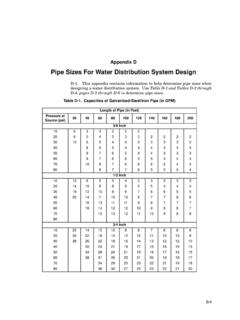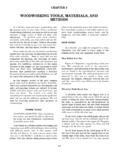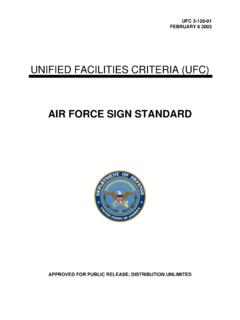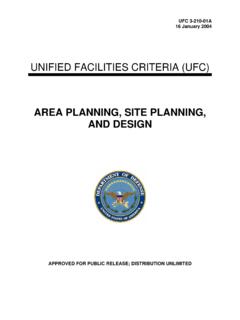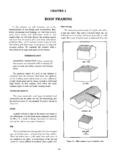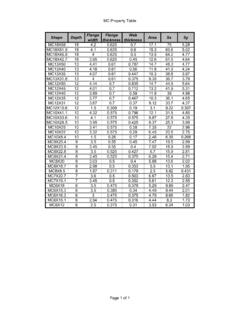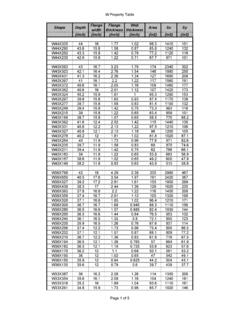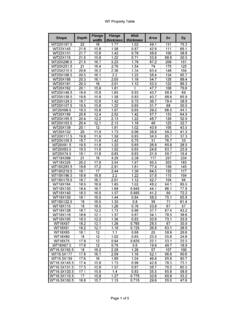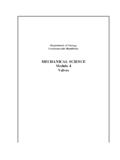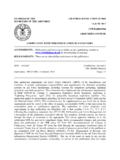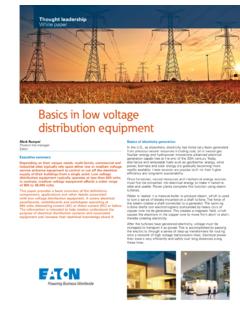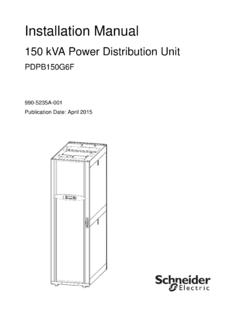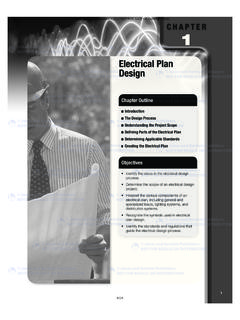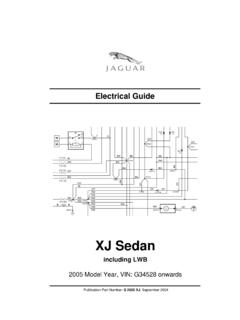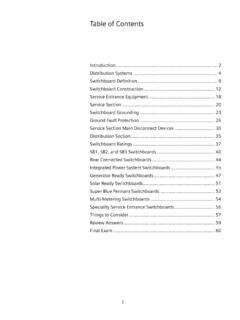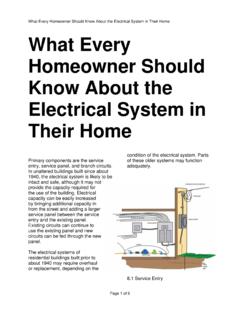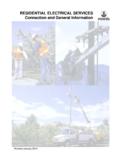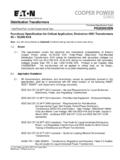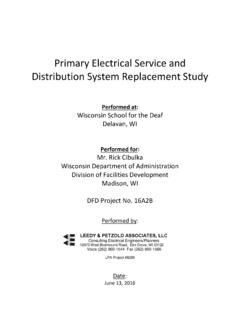Transcription of UFC 3-520-01 Interior Electrical Systems
1 UFC 3-520-01 June 10, 2002 UNIFIED FACILITIES CRITERIA (UFC) Interior Electrical Systems ARMY CORPS OF ENGINEERS NAVAL FACILITIES ENGINEERING COMMAND AIR FORCE CIVIL ENGINEER SUPPORT AGENCY (Preparing Activity) APPROVED FOR PUBLIC RELEASE: DISTRIBUTION UNLIMITED UFC 3-520-01 June 10, 2002 UNIFIED FACILITIES CRITERIA (UFC) UNIFIED FACILITIES GUIDE SPECIFICATIONS (UFGS) FORMAT STANDARD Any copyrighted material included in this UFC is identified at its point of use. Use of the copyrighted material apart from this UFC must have the permission of the copyright holder. Record of Changes (changes are indicated by \1\ .. /1/) Change No. Date Location UFC 3-520-01 June 10, 2002 FOREWORD The Unified Facilities Criteria (UFC) system is prescribed by MIL-STD 3007 and provides planning, design, construction, sustainment, restoration, and modernization criteria, and applies to the Military Departments, the Defense Agencies, and the DoD Field Activities in accordance with USD(AT&L) Memorandum dated 29 May 2002.
2 UFC will be used for all DoD projects and work for other customers where appropriate. All construction outside of the United States is also governed by Status of forces Agreements (SOFA), Host Nation Funded Construction Agreements (HNFA), and in some instances, Bilateral Infrastructure Agreements (BIA.) Therefore, the acquisition team must ensure compliance with the more stringent of the UFC, the SOFA, the HNFA, and the BIA, as applicable. UFC are living documents and will be periodically reviewed, updated, and made available to users as part of the Services responsibility for providing technical criteria for military construction. Headquarters, Army Corps of Engineers (HQUSACE), Naval Facilities Engineering Command (NAVFAC), and Air Force Civil Engineer Support Agency (AFCESA) are responsible for administration of the UFC system .
3 Defense agencies should contact the preparing service for document interpretation and improvements. Technical content of UFC is the responsibility of the cognizant DoD working group. Recommended changes with supporting rationale should be sent to the respective service proponent office by the following electronic form: Criteria Change Request (CCR). The form is also accessible from the Internet sites listed below. UFC are effective upon issuance and are distributed only in electronic media from the following source: Whole Building Design Guide web site Hard copies of UFC printed from electronic media should be checked against the current electronic version prior to use to ensure that they are current. AUTHORIZED BY: _____ DONALD L. BASHAM, Chief, Engineering and Construction Army Corps of Engineers _____DR.
4 JAMES W WRIGHT, Chief Engineer Naval Facilities Engineering Command _____ KATHLEEN I. FERGUSON, The Deputy Civil Engineer DCS/Installations & Logistics Department of the Air Force _____Dr. GET W. MOY, Director, Installations Requirements and Management Office of the Deputy Under Secretary of Defense (Installations and Environment) UFC 3-520-01 June 10, 2002 Hard copies of UFC printed from electronic media should be checked against the current electronic version prior to use to ensure that they are current. AUTHORIZED BY: _____ Dwight A. Beranek, Chief, Engineering and Construction Division Army Corps of Engineers _____ Dr. James W Wright, Chief Engineer Naval Facilities Engineering Command _____ KATHLEEN I. FERGUSON, The Deputy Civil Engineer DCS/Installations & Logistics Department of the Air Force _____ Frank Lane Director of Analysis & Investment Deputy Under Secretary of Defense for Installations and Environment Department of Defense UFC 3-520-01 June 10.
5 2002 i CONTENTS Page CHAPTER 1 GENERAL Paragraph 1-1 1-1 1-2 1-1 1-3 1-1 1-4 CODES AND 1-2 1-5 1-2 1-6 1-3 1-7 MANUAL CONTENT AND 1-3 CHAPTER 2 PRELIMINARY AND DETAILED DESIGN ANALYSIS Paragraph 2-1 PRELIMINARY 2-1 Principal Points of 2-1 Preliminary Design Guidance for Interior Electrical 2-1 Unified Facilities Guide 2-2 2-2 Electrical LOAD 2-2 2-3 OVERVIEW OF DETAILED ANALYSIS 2-3 2-4 SHORT CIRCUIT 2-5 Analysis and Equipment 2-5 Short Circuit 2-5 Symmetrical Versus Asymmetrical 2-6 Short Circuit 2-7 2-5 POWER FLOW 2-8 2-6 VOLTAGE DROP 2-9 Voltage Drop 2-9 Motor Starting 2-9 2-7 Electrical 2-10 2-8 POWER QUALITY AND HARMONIC 2-10 2-9 2-11 2-10 ENERGY 2-11 2-11 New Facility 2-12 Existing 2-13 Energy Efficiency Design Opportunities in the Electrical 2-13 2-11 LIFE-CYCLE COST 2-14 2-12 Electrical 2-15 2-15 One-Line 2-15 Switchgear 2-15 MCC 2-15 2-15 Control Panel Wiring 2-15 Control 2-15 Miscellaneous Interconnection 2-15 Equipment Layouts with Conduit or Cable 2-15 Panel 2-16 Lighting and Receptacle 2-16 Motor 2-16 Conduit or Cable 2-16 UFC 3-520-01 June 10, 2002 ii CHAPTER 3 GENERAL POWER system CRITERIA Paragraph 3-1 3-1 3-1 3-2 Power 3-2 Neutral Conductor 3-2 3-2 NORMAL POWER 3-2 3-3 ALTERNATE AND BACKUP POWER 3-4 3-4 3-5 CHAPTER 4 POWER DISTRIBUTION AND UTILIZATION TRANSFORMERS Paragraph 4-1 4-1 4-1 Voltage and 4-1 Temperature and 4-2 4-4 Number of 4-4 Transformer 4-4 4-5 Basic Impulse Insulation Levels (BILs).
6 4-6 4-2 LOW VOLTAGE 4-6 4-3 MEDIUM VOLTAGE 4-7 4-4 OTHER 4-7 Isolation 4-7 Buck-Boost 4-8 K-Factor 4-9 Specialty 4-10 4-5 TRANSFORMER INSTALLATION 4-10 4-10 Dry-Type 4-10 Less-Flammable, Liquid-Insulated, and Oil-Insulated 4-12 Fire Protection 4-12 4-6 TRANSFORMER 4-12 4-7 INFORMATION 4-13 CHAPTER 5 POWER DISTRIBUTION AND UTILIZATION SWITCHGEAR, LOAD CENTERS, AND BREAKERS Paragraph 5-1 SERVICE 5-1 5-2 SWITCHGEAR AND SWITCHBOARDS GENERAL 5-2 5-3 HIGH VOLTAGE 5-3 5-4 MEDIUM VOLTAGE 5-4 5-4 Low Voltage Conductors in Medium Voltage 5-6 5-5 LOW VOLTAGE BREAKERS AND 5-6 5-6 MOTOR CONTROL 5-9 5-7 DISCONNECT 5-9 5-8 CIRCUIT LOCKOUT 5-10 UFC 3-520-01 June 10, 2002 iii 5-9 INFORMATION 5-10 CHAPTER 6 POWER DISTRIBUTION AND UTILIZATION RACEWAY AND WIRING Paragraph 6-1 RACEWAY 6-1 6-2 WIRING system 6-3 6-3 SIZING WIRING Systems FOR ENERGY 6-6 6-4 CONVENIENCE OUTLETS AND 6-7 6-5 WIRING FOR TEMPORARY POWER AND 6-8 6-6 ACCEPTANCE TESTING OF WIRING 6-10 CHAPTER 7 POWER DISTRIBUTION AND UTILIZATION MOTORS AND MOTOR CONTROL CIRCUITS Paragraph 7-1 BASIC MOTOR 7-1 7-2 MOTOR CONTROL 7-3 7-3 ADJUSTABLE SPEED 7-5 CHAPTER 8 POWER DISTRIBUTION AND UTILIZATION OTHER DESIGN CRITERIA Paragraph 8-1 Electrical EQUIPMENT CLEARANCES AND 8-1 8-1 Equipment Rated 600 Volts and 8-1 Equipment Rated Above 600 8-5 8-2 8-5 8-3 HAZARDOUS 8-8 8-4 400-HERTZ DISTRIBUTION 8-10 8-5 8-11 8-6 POWER FACTOR 8-11 CHAPTER 9 Electrical system PROTECTION AND COORDINATION
7 Paragraph 9-1 PROTECTION system DESIGN .. 9-1 9-2 Electrical COORDINATION ANALYSIS 9-1 9-1 Coordination Study 9-2 Coordination Time 9-3 Pickup 9-5 Coordination 9-5 Coordination 9-8 Coordination Study 9-10 9-3 PROTECTIVE 9-10 9-4 INSTRUMENT 9-12 9-12 Current 9-12 Potential 9-12 9-5 9-12 9-6 OVERLOAD 9-14 9-7 CIRCUIT 9-16 9-8 PROTECTIVE DEVICE 9-17 9-9 INFORMATION 9-21 UFC 3-520-01 June 10, 2002 iv CHAPTER 10 GROUNDING, BONDING, AND LIGHTNING PROTECTION Paragraph 10-1 10-1 10-2 NEC GROUNDING AND BONDING 10-1 10-3 STATIC 10-1 10-4 COMMUNICATIONS Systems GROUNDING AND BONDING. 10-2 Introduction .. 10-2 Connection to the Grounding 10-3 Commercial Building Grounding and Bonding Requirements for 10-4 10-5 LIGHTNING 10-5 10-6 INFORMATION 10-5 CHAPTER 11 SURGE PROTECTION Paragraph 11-1 11-1 11-2 SURGE PROTECTION 11-2 Parallel Versus Series 11-2 Multiple Layer Protection 11-2 11-3 INSTALLATION 11-4 Minimizing Lead Length for Parallel Surge 11-4 Breaker 11-6 11-7 Acceptance 11-7 Periodic 11-8 11-4 SURGE PROTECTION FOR COMMUNICATIONS AND RELATED 11-8 CHAPTER 12 POWER system QUALITY Paragraph 12-1 INTRODUCTION.
8 12-1 12-2 UNBALANCED 12-1 12-3 HARMONIC DISTORTION 12-2 12-4 HARMONIC CURRENT EFFECTS ON 12-3 12-5 POWER QUALITY 12-5 12-6 NONLINEAR LOAD DESIGN 12-8 12-7 NEUTRAL CIRCUIT SIZING FOR NONLINEAR 12-9 Potential Neutral Current Magnitudes .. 12-9 Installation Design 12-10 12-8 INFORMATION 12-11 CHAPTER 13 EMERGENCY AND STANDBY POWER Systems Paragraph 13-1 ESTABLISHING THE NEED FOR BACKUP 13-1 13-2 CLASSIFYING EMERGENCY POWER 13-3 13-3 ENGINE 13-4 13-4 UPS 13-7 13-7 Selection and 13-7 13-8 Selection of a Large UPS system or Multiple Smaller UPS 13-10 UFC 3-520-01 June 10, 2002 v Design 13-11 Site Survey for an 13-12 13-5 AUTOMATIC TRANSFER 13-12 13-12 Transfer 13-13 Design 13-16 Static Transfer 13-19 13-20 Effect of Motor 13-20 Maintaining Ground Fault 13-22 Additional system Design 13-22 Information 13-22 CHAPTER 14 STATIONARY BATTERY Systems 14-1 STATIONARY 14-1 14-1 Battery Areas and Battery 14-2 Installation Design 14-6 14-2 BATTERY 14-8 14-3 BATTERY 14-9 CHAPTER 15 LIGHTING Paragraph 15-1 LIGHTING DESIGN 15-1 CHAPTER 16 COMMUNICATIONS AND INFORMATION Systems Paragraph 16-1 16-1 16-2 ARMY DESIGN 16-1 16-3 NAVY DESIGN 16-1 16-4 AIR FORCE DESIGN 16-1 CHAPTER 17 AUXILIARY Systems Paragraph 17-1 FIRE ALARM AND DETECTION 17-1 17-2 SECURITY Systems .
9 17-1 17-3 TELEVISION 17-1 17-4 CLOCK 17-4 17-5 ENERGY MANAGEMENT AND CONTROL 17-5 CHAPTER 18 FACILITY-SPECIFIC DESIGN CRITERIA Paragraph 18-1 MEDICAL 18-1 18-2 POWER DISTRIBUTION FOR AIRCRAFT HANGARS (SHELTERS) .. 18-1 18-3 HIGH-ALTITUDE ELECTROMAGNETIC PULSE (HEMP) AND TEMPEST 18-2 18-4 SEISMICALLY QUALIFIED 18-3 18-5 TROPICAL 18-3 18-6 ARCTIC 18-3 18-7 GENERAL FACILITY 18-3 UFC 3-520-01 June 10, 2002 vi GLOSSARY APPENDIX A REFERENCES APPENDIX B CALCULATION METHODS AND EXAMPLES APPENDIX C CAPACITORS FOR POWER FACTOR CORRECTION APPENDIX D SURGE PROTECTOR PERFORMANCE AND EVALUATION CRITERIA APPENDIX E STATIONARY BATTERY AND CHARGER SIZING APPENDIX F Interior LIGHTING APPENDIX G AIR FORCE COMMUNICATIONS AND INFORMATION Systems UFC 3-520-01 June 10, 2002 vii FIGURES Figure Title 2-1 Computer Model of Electrical 2-4 2-2 Completely Symmetric or Asymmetric 2-7 2-3 Typical Asymmetrical Short Circuit 2-7 3-1 Single Power Feed to 3-3 3-2 Redundant Power Feed to 3-4 4-1 Insulation system 4-3 4-2 Spacing Requirements for Transformers Rated kVA or 4-11 4-3 Spacing Requirements for Transformers Rated Over 4-11 4-4 Installation Requirements for Transformers Rated Over 35.
10 000 4-12 8-1 Equipment Positioning to Allow Escape Around 8-1 8-2 Associated Equipment Maximum Extension into Work 8-3 8-3 Dedicated Clear Space Above 8-4 9-1 Selective Coordination 9-7 9-2 Selective Coordination Example with 9-8 9-3 Simplified Solid-State Trip 9-16 10-1 Purpose of Static 10-2 11-1 Simplified Facility 11-3 11-2 Optimal Installation of Surge Protector Leads First 11-4 11-3 Optimal Installation of Surge Protector Leads Second 11-5 11-4 Unacceptable Installation with Long Surge Protector 11-6 11-5 Less-Than-Optimal Installation by Including Safety 11-6 12-1 Typical Derating Factor for Three-Phase Induction 12-2 12-2 Effect of Single Phase Nonlinear Loads on Neutral 12-10 13-1 Open Transition 13-14 13-2 Closed Transition 13-15 13-3 Induction Motor Open Circuit Voltage 13-21 14-1 Battery Room 14-3 14-2 Two-Step Battery Rack Configuration (End View).
